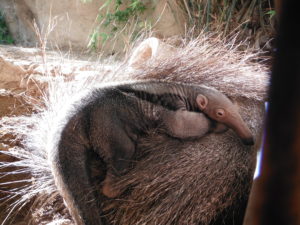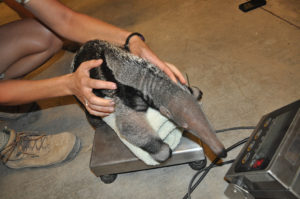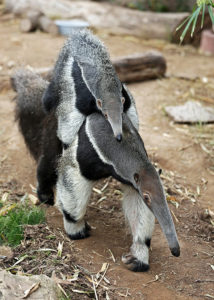50 Years of Giant Anteaters!
In 1968, Reid Park Zoo introduced the Tucson community to its first pair of giant anteaters. These new animals were a big change from the Zoo’s previous collection of birds, prairie dogs, farm animals and squirrel monkeys.

This year will mark the 50th anniversary of giant anteaters being at Reid Park Zoo. Over the last five decades, there have been many successful births. Through this success, came great responsibility. Reid Park Zoo currently holds the Association of Zoos and Aquariums (AZA) Studbook of giant anteaters. To ensure consistency, one member of the animal care team is designated and trained as the Studbook Keeper.
The purpose of a studbook is to document the pedigree and entire demographic history of each animal among AZA-accredited institutions. These collective histories are valuable tools to responsibly track and manage each individual as part of the population.
 On September 27, 2012, the Zoo’s giant anteaters Zoe and Xander, successfully gave birth to Zola, Reid Park Zoo’s current female giant anteater. The AZA Studbook of giant anteaters played a critical role in determining which animals would be genetically compatible to breed with her successfully.
On September 27, 2012, the Zoo’s giant anteaters Zoe and Xander, successfully gave birth to Zola, Reid Park Zoo’s current female giant anteater. The AZA Studbook of giant anteaters played a critical role in determining which animals would be genetically compatible to breed with her successfully.
“Zoe was initially a nervous but great mom to Zola,” said Sue Tygielski, interim Zoo Administrator. “Through positive reinforcement training, Zoe would let staff weigh Zola while she enjoyed her favorite treat, smashed avocado. Even though Zola grew up fast, Zoe still carried her on her back long after most moms would have stopped carrying due to her size.”
 Today, Zola shares a habitat with a male anteater named Nico in the Tropical Trail, next to the capybaras. Typically male giant anteaters are larger than the female but Zola outweighs Nico by thirty pounds! Giant anteaters are solitary animals, but they do come together to breed and raise their young. The AZA has given a breeding recommendation to Zola and Nico but Keepers are still working on introducing the pair through positive reinforcement training.
Today, Zola shares a habitat with a male anteater named Nico in the Tropical Trail, next to the capybaras. Typically male giant anteaters are larger than the female but Zola outweighs Nico by thirty pounds! Giant anteaters are solitary animals, but they do come together to breed and raise their young. The AZA has given a breeding recommendation to Zola and Nico but Keepers are still working on introducing the pair through positive reinforcement training.
Reid Park Zoo is committed to protecting anteaters and their habitat. Anteaters are one of the most frequently killed animals on roadways throughout the Brazilian Cerrado habitat. The Giant Anteaters and Highways program is investigating the reasons behind this in hopes of protecting the anteaters’ population from becoming extinct. We are a proud supporter of the Giant Anteaters and Highways program in Brazil and you can help protect anteaters by visiting the Reid Park Zoo. Every giraffe encounter sold goes directly into the Zoo’s conservation fund to help protect wild animals and wild places.
Giant Anteater Fun Facts
- The giant anteater has the longest tongue in relation to its body size of any mammal and can flick it about 150 times per minute.
- The giant anteater’s sense of smell is 40 times more powerful than ours.
- The giant anteater’s narrow tongue enables insects to bite and sting the animal’s nose when feeding.
Did You Know:
You can become a “Parent” to your favorite Zoo animal, the giant anteater. It’s easy, fun and most importantly, your adoption fee supports Reid Park Zoo. Click here to Adopt-an-Animal today!
